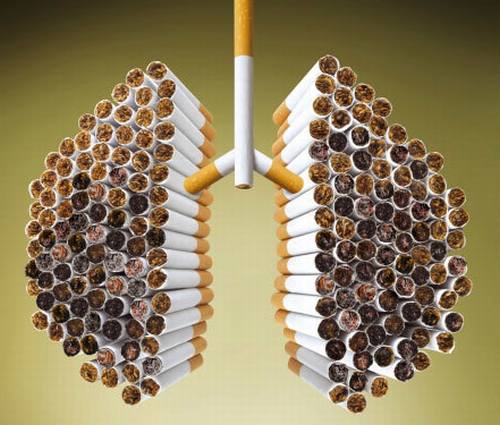
Smoking
(A Deadly Habit)
The use of tobacco products has been controversial for many years. During the 1500s, European physicians declared that tobacco should be used only for medicinal purposes. The Puritans in America considered it a dangerous narcotic. During the 1960s, scientists established that smoking tobacco products—especially cigarettes—could result in lung cancer, heart disease and other illnesses.
Some cigarette manufacturers reacted to the medical findings by reducing the tar and nicotine content of cigarettes. However, doctors state that these measures have not eliminated the dangers of smoking.
TOBACCO TOXINS
Cigarette smoke has more than 3,000 chemical substances, and several of them have been linked to the development of diseases. The most dangerous substances are (1) carbon monoxide, (2) nicotine, (3) tars, (4) smoke particles.
CARBON MONOXIDE is a poisonous gas that interferes with the blood’s ability to carry oxygen. It also contributes to heart disease and lung disorders and results in changes in the blood vessels that may lead to hardening of the arteries.
Carbon monoxide has long been recognized as a dangerous gas. Some symptoms of carbon monoxide poisoning include headache, vertigo, dyspnea, confusion, dilated pupils, convulsions and coma.
Carbon monoxide at levels of exposure commonly reached by cigarette smokers, has been shown to decrease cardiac contractibility in persons with coronary heart disease. It has also been shown to produce changes like those of early atherosclerosis in the aortas in rabbits.
NICOTINE results in stimulation of the nervous system, and the heart, and other internal organs. The effect on the nervous system is one of the reasons why people have such a hard time giving up smoking. Nicotine is poisonous.
Nicotine is a colorless, oily, transparent vegetable chemical compound of the type called an alkaloid. It has a hot and bitter taste. It is found in small quantities in the leaves, roots, and seeds of the tobacco plant. It can also be made synthetically.
The quantity of nicotine in most tobacco ranges from 2-7 percent. It is most abundant in the cheaper domestic varieties. Nicotine as mentioned is exceedingly poisonous. In a pure state, even a small quantity will result in vomiting, great weakness, rapid but weak pulse, and possibly collapse or even death.
TARS contain small quantities of carcinogenic substances. They are believed to be one of the major factors that lead to lung cancer and other types of cancer among smokers.
The tar from cigarette smoke has been found to result in malignant changes in the skin and respiratory tract of experimental animals, and a number of specific chemical compounds contained in cigarette smoke were established as potent carcinogens or co-carcinogens. Malignant changes including carcinoma are found in the larynx.
SMOKE PARTICLES are as small 1/70,000 inch. A smoker inhales most of the particles, but as many as 25 percent of them may be trapped on the lining of the lungs. The particles are later absorbed by cells in the lining. This absorption may cause the cells to function improperly and damage the lining of the lung. The particles can also cause excessive scar tissues within the walls of the lungs. Smoke particles probably help cause progressive destruction of the walls of the air sacs in the lungs of long-term smokers.
These irritants cause immediate coughing and bronco-constriction after smoke inhalation.
CIGARETTE SMOKING AND CHRONIC DISEASE
Studies have shown that individuals who smoke more than one pack per day are about 20 times more at risk of developing lung cancer than are nonsmokers. Laboratory experiments show that tobacco smoke condensate can produce skin cancer in animals and that animals inhaling cigarette smoke may develop cancer of the larynx or lung.
Chronic bronchitis and emphysema deaths are also about 20 times more frequent in people who smoke heavily. Both diseases can be produced in animals exposed to cigarette smoke.
Cigarette smoking accelerates atherosclerosis and may double the risk of myocardial infarction. Smoking may precipitate a heart attack. The risk of developing cerebrovascular disease, peripheral vascular disease, or aortic blood clots is also increased in smokers.
Coronary heart disease is the most frequent cause of death in the United States and is the most important single cause of excess mortality among cigarette smokers.
Cigarette smoking and hypertension and elevated serum cholesterol are the major risk factors for myocardial infarction and death from coronary heart disease.
Peptic ulceration occurs more frequently and has a higher mortality rate in cigarette smokers than in nonsmokers. In addition, the rate of ulcer healing is slowed.
EFFECTS ON FETUS AND CHILDREN
If a pregnant woman smokes, it has adverse effects on her unborn baby. There is abundant evidence that maternal smoking directly retards the rate of fetal growth and increases the risk of spontaneous abortion, of fetal death and of infant death in otherwise normal babies. There is also some evidence that children of some smokers are more likely to have measurable deficiencies in physical growth and development.
When the mother smokes, some of the harmful gases and poisonous substances in the smoke actually pass from her blood through the placenta and into the fetal bloodstream. One of these gases is carbon monoxide, which forces the oxygen out of the red blood cells. Another powerful poison, nicotine, adds to the damage by narrowing blood vessels, including those in the placenta itself. This decreases the amount of oxygen and food delivered to the unborn baby.
Although the fetus does not breath before the moment of birth, it nevertheless practices some motions of breathing by exercising certain chest muscles. These movements slow down after the mother inhales just two cigarettes. Even when women quite smoking before pregnancy, their earlier smoking may still result in damage to the fetus, according the one extensive study.
Several researchers have investigated the effects of parental smoking on the health of children. One group of researchers conducted two telephone surveys of Detroit families to determine the relationship between children’s respiratory illnesses and parental smoking habits. In both surveys, they found statistically significant relationships between the prevalence of children’s respiratory inflammation and parental smoking habits.
INVOLUNTARY SMOKING
The effects of smoking on the smoker has been extensively studied, but the effects of tobacco smoke on nonsmokers has only recently received much attention. The chemical constituents found in an atmosphere filled with tobacco smoke are derived from two sources—mainstream and sidestream smoke. Mainstream smoke emerges from the tobacco product after being drawn through the tobacco during puffing. Sidestream smoke rises from the burning cone of tobacco. Mainstream and sidestream smoke contribute different concentrations of many substances to the atmosphere for several reasons. Different amounts of tobacco are consumed in the production of mainstream and sidestream smoke; the temperature of combustion differs for tobacco during puffing or while smouldering; and certain substances are partially absorbed from the mainstream smoke by the smoker.
Sitting next to a smoker, a nonsmoker can be exposed to carbon monoxide levels more than twice as high as the maximum set for industry exposure. When nonsmoker leave a smoky environment, it takes hours for the carbon monoxide to leave their bodies. Unlike oxygen, which is breathed in and then out again in minutes, carbon monoxide in the blood lasts for hours. After three or four hours, half of the excess carbon monoxide is still in the bloodstream. Not enough research has been done on other toxic substances inhaled by nonsmokers in the presence of smoke: formaldehyde, oxides of nitrogen, ammonia, cadmium, hydrogen cyanide, pyrene, and hundreds more.
A LIST OF A FEW POISONS IN CIGARETTES
Here is a short list of some the most poisonous matter present in cigarettes.
*Carbon monoxide—prevents oxidation of blood.
*Nicotine--half a drop is fatal.
*Formic alderyde—a strong irritant.
*Carbolic acid—burns your throat.
*Pyridine—
*Furfural—responsible for “short windedness” and tremors.
*Acrolein—degenerates the brain cells.
*Salt petre in the paper keeps the “cigarette burning.” One cigarette causes a rise of 10-15 points in your blood pressure, ie, increasing the work of your heart by 10%.
There are no safe cigarettes. Not even filters on the tip of cigarettes do not make them any safer. In fact one study suggests that a smoker who switches from a non filter to filter cigarettes may actually face an increased risk of coronary heart disease, primarily because of the higher carbon monoxide levels in smoke inhaled though filters. The paper surrounding the filter is relatively nonporous, and thus more carbon monoxide is passed on to the smoker than if no filter were present.
ELIMINATING THE SMOKING HABIT
Cigarette smoking is destructive to your health, your children’s health, and to the health of all those close to you. It is a waste of vital energy and is a deadly habit.
The safest, quickest, and surest way to eliminate smoking is to fast for a day or two and to stop smoking “cold turkey.” The smoker who has intentions of quitting by tapering off is in most cases bound to failure, as he or she, month after month, teases himself, with a limited supply of cigarettes while all the while the unsatisfied urge to smoke that becomes strong becomes stronger. Of course some have succeeded on this plan, but those who have, would have succeeded on the abrupt stopping plan.
Attitude of mind toward tobacco must change as well as taking on better living habits such as greater physical activity, increased walking; greater use of the lungs through deeper breathing; a diet of lots of fresh fruits, vegetables, whole grains, and drinking lots of water is very important in breaking this most deadly habit!
“The cigarette companies have deliberately created their industry definitions to make the smoker think they are smoking something safer than they are really smoking. The whole purpose of this exercise is the same as the “Low Tar/Lights” Idea to keep smokers unworried, while keeping their level of addiction as high as possible.”
Switch Down And Quit: What The Cigarette Co Don’t Want You To Know About Smoking
Whether therefore ye eat or drink, or whatsoever ye do, do all to the glory of God.
1 Corinthians 10:31
Katy Chamberlin
